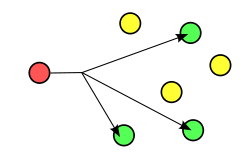Multicast

|
|
|---|
|
|
|
|
|
|
|
|
|
|
In computer networking, multicast (one-to-many or many-to-many distribution[1]) is group communication[2] where information is addressed to a group of destination computers simultaneously. Group communication may either be application layer multicast[2] or network assisted multicast, where the latter makes it possible for the source to efficiently send to the group in a single transmission. Copies are automatically created in other network elements, such as routers, switches and cellular network base stations, but only to network segments that currently contain members of the group.
Network assisted multicast may be implemented at the Data Link Layer using one-to-many addressing and switching such as Ethernet multicast addressing, Asynchronous Transfer Mode (ATM) point-to-multipoint virtual circuits (P2MP) or Infiniband multicast. Network assisted multicast may also be implemented at the Internet layer using IP multicast. In IP multicast the implementation of the multicast concept occurs at the IP routing level, where routers create optimal distribution paths for datagrams sent to a multicast destination address.
Multicast is often employed in Internet Protocol (IP) applications of streaming media, such as Internet television scheduled content (but not media-on-demand) and multipoint videoconferencing, but also for ghost distribution of backup disk images to multiple computers simultaneously.
Multicast should not be confused with physical layer point-to-multipoint communication.
IP multicast
IP multicast is a technique for one-to-many communication over an IP infrastructure in a network. The destination nodes send join and leave messages, for example in the case of Internet television when the user changes from one TV channel to another. IP multicast scales to a larger receiver population by not requiring prior knowledge of who or how many receivers there are. Multicast uses network infrastructure efficiently by requiring the source to send a packet only once, even if it needs to be delivered to a large number of receivers. The nodes in the network take care of replicating the packet to reach multiple receivers only when necessary.
The most common transport layer protocol to use multicast addressing is User Datagram Protocol (UDP). By its nature, UDP is not reliable—messages may be lost or delivered out of order. By adding loss detection and retransmission mechanisms, reliable multicast has been implemented on top of UDP or IP by various middleware products, e.g. those that implement the Real-Time Publish-Subscribe (RTPS) Protocol of the Object Management Group (OMG) Data Distribution Service (DDS) standard, as well as by special transport protocols such as Pragmatic General Multicast (PGM).
IP multicast is widely deployed in enterprises, commercial stock exchanges, and multimedia content delivery networks. A common enterprise use of IP multicast is for IPTV applications such as distance learning and televised company meetings.
As of 2006, most effort at scaling multicast up to large networks has concentrated on the simpler case of single-source multicast, which seems to be more computationally tractable.
Still, the large state requirements in routers make applications using a large number of trees unable to work while using IP multicast. Take presence information as an example where each person needs to keep at least one tree of its subscribers, if not several. No mechanism has yet been demonstrated that would allow the IP multicast model to scale to millions of senders and millions of multicast groups and, thus, it is not yet possible to make fully general multicast applications practical. For these reasons, and also reasons of economics, IP multicast is not, in general, used in commercial Internet backbones.
Application layer multicast
Application layer multicast-over-unicast overlay services are not based on IP multicast or datalink layer multicast. These services are designed for application-level group communication. Internet Relay Chat (IRC) implements a single spanning tree across its overlay network for all conference groups.[3] The lesser known PSYC technology uses custom multicast strategies per conference.[4] Some peer-to-peer technologies employ the multicast concept when distributing content to multiple recipients, known as peercasting.
Explicit multi-unicast (Xcast) is an alternate multicast strategy that includes addresses of all intended destinations within each packet. As such, given maximum transmission unit limitations, Xcast cannot be used for multicast groups with many destinations. The Xcast model generally assumes that stations participating in the communication are known ahead of time, so that distribution trees can be generated and resources allocated by network elements in advance of actual data traffic.[5]
Multicast over wireless networks and cable-TV
Wireless communications (with exception to point-to-point radio links) as well as cable TV bus networks are inherently broadcasting media especially if the antennas are omnidirectional. However, the communication service provided may be unicast, multicast as well as broadcast, depending on if the data is addressed to one, to a group or to all receivers in the covered network, respectively.
In digital-TV, the concept of multicast service sometimes is used to refer to content protection by broadcast encryption, i.e. encrypted content over a simplex broadcast channel only addressed to paying viewers (pay television). In this case, data is broadcast (or distributed) to all receivers, but only addressed to a specific group.
The concept of interactive multicast, for example using IP multicast, may be used over TV broadcast networks to improve efficiency, offer more TV programs, or reduce the required spectrum. Interactive multicast implies that TV programs are sent only over transmitters where there are viewers, and that only the most popular programs are transmitted. It relies on an additional interaction channel (a back-channel or return channel), where user equipment may send join and leave messages when the user changes TV channel. Interactive multicast has been suggested as an efficient transmission scheme in DVB-H and DVB-T2 terrestrial digital television systems,[6] A similar concept is switched broadcast over cable-TV networks, where only the currently most popular content is delivered in the cable-TV network.[7]
TV gateways converts Satellite: DVB-S, DVB-S2, Cable: DVB-C, DVB-C2 and Terrestrial television: DVB-T, DVB-T2 to IP for distribution using unicast and multicast in home, hospitality and enterprise applications
Another similar concept is Cell-TV, i.e. implies TV distribution over 3G cellular networks using the network-assisted multicasting offered by the Multimedia Broadcast Multicast Service (MBMS) service, or over 4G/LTE cellular networks with the eMBMS (enhanced MBMS) service.
Scalable video multicast in an application of interactive multicast, where a subset of the viewers receive additional data for high-resolution video.
Other multicast technologies
In an optical mesh network, protecting multicast lightpaths is one of the key concerns. The most straight forward approach to protect a multicast tree is to establish a link-disjoint backup tree which establishes dedicated protection. It is much easier to find an arc-disjoint path for each leaf node in a light tree. The essence of protecting a multicast session is to find a backup path for each destination node when a link on the working path to that node fails.
See also
- 802.1aq
- Ad hoc routing protocol list for more multicast protocols
- Anycast
- Any-source multicast
- Broadcast address
- CastGate, an attempt at providing connectivity to the multicast network for hosts that have none
- Comparison of streaming media systems
- Comparison of video services
- Content delivery network
- Flooding algorithm
- IGMP
- IP speaker
- Internet television
- List of music streaming services
- List of streaming media systems
- Mbone (Multicast backbone)
- Multicast address
- NBMA Nonbroadcast Multiple Access Network
- Packet forwarding
- P2PTV
- Protection of Broadcasts and Broadcasting Organizations Treaty
- Push technology
- Session Announcement Protocol
- Source-specific multicast
- VideoLAN, a free software multicasted video streaming application
- Web television
- Webcast
References
- ↑ Lawrence Harte, Introduction to Data Multicasting, Althos Publishing 2008.
- 1 2 Media-communication based on Application-Layer Multicast
- ↑ RFC 1324 2.5.1 Size, IETF.
- ↑ White paper, EU: PSYC.
- ↑ Rick Boivie; Nancy Feldman; Yuji Imai; Wim Livens & Dirk Ooms (November 2007). "Explicit Multicast (Xcast) Concepts and Options". Retrieved May 25, 2013.
- ↑ M. Eriksson, S.M. Hasibur Rahman, F. Fraille, M. Sjöström, ”Efficient Interactive Multicast over DVB-T2 - Utilizing Dynamic SFNs and PARPS”, 2013 IEEE International Conference on Computer and Information Technology (BMSB’13), London, UK, June 2013.
- ↑ N. Sinha, R. Oz and S. V. Vasudevan, “The statistics of switched broadcast”, Proceedings of the SCTE 2005 Conference on Emerging Technologies, Tampa, FL, USA, January 2005
| Wikiversity has learning materials about Multicast |




